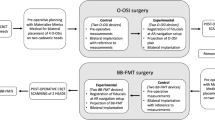Abstract
Purpose
Most of the current Bonebridge surgeries undergo preoperative simulation planning in a computer. However, surgeons usually use the landmarks on the bone surface to determine the location where to implant the device, using the simulation image in the computer only as a reference (conventional method). We developed an image-guided method for precisely replicating simulation surgery upon performing Bonebridge implantation.
Methods
Based on our previous development of the surface template-assisted marker positioning (STAMP) method for performing image-guided otologic surgery, we fabricated templates that fit only at the designated location on the patient’s temporal bone surface. The Bonebridge STAMP (BB-STAMP) plate shows the exact location where to start drilling. The BB-STAMP was also combined with a perforator-guiding sleeve, so that the location, direction and depth of the cylindrical well could be precisely replicated as simulated. We also created a STAMP plate for confirmation that fits only after sufficient drilling at the correct location is finished. To evaluate the proposed methods, we performed simulation surgery on four cadaveric temporal bones and their 12 replicas (three each for four bones). The time used and the degree of mismatch between the simulated location and the drilled location were compared.
Results
A feasibility study was successfully conducted using the proposed BB-STAMP methods and the conventional method. The amount of time required for the procedure did not differ significantly between the surgical methods, although using the BB-STAMP and perforator guide was always quicker. The degree of mismatch between the simulation and resected models had tendency to be smaller when the surgery was guided by the BB-STAMP with or without a perforator guide, although the difference was not statistically significant.
Conclusions
The proposed BB-STAMP is a promising method for replicating exactly what is performed during simulation without using a surgical navigation system.










Similar content being viewed by others
References
Sprinzl G, Lenarz T, Ernst A, Hagen R, Wolf-Magele A, Mojallal H, Todt I, Mlynski R, Wolframm MD (2013) First European multicenter results with a new transcutaneous bone conduction hearing implant system: short-term safety and efficacy. Otol Neurotol 34(6):1076–1083. doi:10.1097/MAO.0b013e31828bb541
Huber AM, Sim JH, Xie YZ, Chatzimichalis M, Ullrich O, Roosli C (2013) The Bonebridge: preclinical evaluation of a new transcutaneously-activated bone anchored hearing device. Hear Res 301:93–99. doi:10.1016/j.heares.2013.02.003
Barbara M, Perotti M, Gioia B, Volpini L, Monini S (2013) Transcutaneous bone-conduction hearing device: audiological and surgical aspects in a first series of patients with mixed hearing loss. Acta Otolaryngol 133(10):1058–1064. doi:10.3109/00016489.2013.799293
Wimmer W, Guignard J, Gerber N, Kompis M, Weber S, Caversaccio M (2013) A preoperative planning method for Bonebridge implantations using surface distance maps. Int J Comput Assist Radiol Surg 8(Suppl 1):S356–S357
Lassaletta L, Sanchez-Cuadrado I, Munoz E, Gavilan J (2013) Retrosigmoid implantation of an active bone conduction stimulator in a patient with chronic otitis media. Auris Nasus Larynx. doi:10.1016/j.anl.2013.04.004
Canis M, Ihler F, Blum J, Matthias C (2013) [CT-assisted navigation for retrosigmoidal implantation of the Bonebridge.]. HNO. doi:10.1007/s00106-012-2652-5
Oka M, Cho B, Matsumoto N, Hong J, Jinnouchi M, Ouchida R, Komune S, Hashizume M (2013) A preregistered STAMP method for image-guided temporal bone surgery. Int J Comput Assist Radiol Surg. doi:10.1007/s11548-013-0916-5
Matsumoto N, Hong J, Hashizume M, Komune S (2009) A minimally invasive registration method using surface template-assisted marker positioning (STAMP) for image-guided otologic surgery. Otolaryngol Head Neck Surg 140(1):96–102. doi:10.1016/j.otohns.2008.10.005
Guldner C, Heinrichs J, Weiss R, Zimmermann AP, Dassinger B, Bien S, Werner JA, Diogo I (2013) Visualisation of the Bonebridge by means of CT and CBCT. Eur J Med Res 18(1):30. doi:10.1186/2047-783X-18-30
Kunz M, Rudan JF, Xenoyannis GL, Ellis RE (2010) Computer-assisted hip resurfacing using individualized drill templates. J Arthroplasty 25(4):600–606. doi:10.1016/j.arth.2009.03.023
Berry E, Cuppone M, Porada S, Millner PA, Rao A, Chiverton N, Seedhom BB (2005) Personalised image-based templates for intra-operative guidance. Proc Inst Mech Eng H 219(2):111–118
Radermacher K, Portheine F, Anton M, Zimolong A, Kaspers G, Rau G, Staudte HW (1998) Computer assisted orthopaedic surgery with image based individual templates. Clin Orthop Relat Res 354:28–38
Acknowledgments
The authors thank Mr. H. Ono and Mr. H. Sugiyama (Ono and Co.) for their technical assistance in producing the BB-STAMP and C-STAMP plates. The authors also thank Mr. G. Ball, Mr. P. Grasso, Mr. M. Nagl (Med-EL Austria) and Ms. Y. Kawabata (Med-EL Japan) for providing us with precise information and surgical instructions for the Bonebridge product, which is not approved for clinical use in Japan. Mr. P. Grasso has also helped us with critical reading of the manuscript. This study was supported by the Japan Society for the Promotion of Science (JSPS) KAKENHI Grant No. 24500549 to N.M.
Conflict of interest
B.C., M.M., S.K., and M.H.: None. N.M. is an applicant of patents related to the STAMP method; thus, he declared this fact as a potential conflict of interest.
Author information
Authors and Affiliations
Corresponding author
Rights and permissions
About this article
Cite this article
Cho, B., Matsumoto, N., Mori, M. et al. Image-guided placement of the Bonebridge\(^\mathrm{TM}\) without surgical navigation equipment. Int J CARS 9, 845–855 (2014). https://doi.org/10.1007/s11548-013-0973-9
Received:
Accepted:
Published:
Issue Date:
DOI: https://doi.org/10.1007/s11548-013-0973-9




